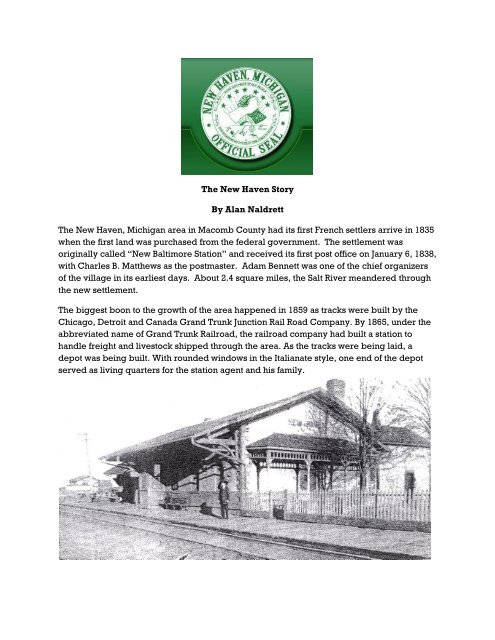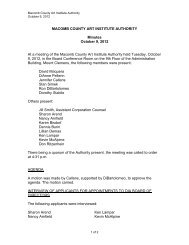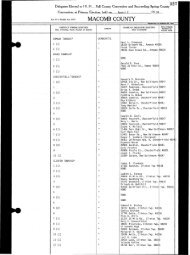The New Haven Story By Alan Naldrett The New ... - Macomb County
The New Haven Story By Alan Naldrett The New ... - Macomb County
The New Haven Story By Alan Naldrett The New ... - Macomb County
Create successful ePaper yourself
Turn your PDF publications into a flip-book with our unique Google optimized e-Paper software.
<strong>The</strong> <strong>New</strong> <strong>Haven</strong> <strong>Story</strong><br />
<strong>By</strong> <strong>Alan</strong> <strong>Naldrett</strong><br />
<strong>The</strong> <strong>New</strong> <strong>Haven</strong>, Michigan area in <strong>Macomb</strong> <strong>County</strong> had its first French settlers arrive in 1835<br />
when the first land was purchased from the federal government. <strong>The</strong> settlement was<br />
originally called “<strong>New</strong> Baltimore Station” and received its first post office on January 6, 1838,<br />
with Charles B. Matthews as the postmaster. Adam Bennett was one of the chief organizers<br />
of the village in its earliest days. About 2.4 square miles, the Salt River meandered through<br />
the new settlement.<br />
<strong>The</strong> biggest boon to the growth of the area happened in 1859 as tracks were built by the<br />
Chicago, Detroit and Canada Grand Trunk Junction Rail Road Company. <strong>By</strong> 1865, under the<br />
abbreviated name of Grand Trunk Railroad, the railroad company had built a station to<br />
handle freight and livestock shipped through the area. As the tracks were being laid, a<br />
depot was being built. With rounded windows in the Italianate style, one end of the depot<br />
served as living quarters for the station agent and his family.
It was 1859 when the famous inventor Thomas Edison was only12 years old and got a job as a<br />
“news butch” aboard the train. He would load up in Port Huron with magazines, cigars,<br />
postcards, newspapers, and snacks to sell on the train and on the platform when the train<br />
would stop. <strong>The</strong>refore, he was a frequent visitor to the <strong>New</strong> <strong>Haven</strong> area.<br />
Around the 1900s, mail would be loaded off the train and put on a four-wheeled cart (as<br />
pictured) and then transferred to a two wheel cart by a man named Rudolph who would then<br />
rush it to the post office.<br />
In 1928, the train route was officially merged into the Grand Trunk Western route.<br />
In 1940, in publicity for the movie Young Tom Edison, Mickey Rooney, who played Tom<br />
Edison in the movie, took an 8 car train from Port Huron to Detroit and made various stops<br />
along the way, including the <strong>New</strong> <strong>Haven</strong> Depot, where he was greeted by over half the<br />
village. While the train was moving, Mickey Rooney, dressed as Tom Edison, walked<br />
through the train hawking newspapers, candy, etc. just as Tom had originally done.<br />
Train service for passengers lasted until July, 1954. <strong>The</strong> depot was then used for storage,<br />
even having a garage door cut into the side to facilitate the moving of items into the depot.<br />
In 1990 the railroad company decided that the depot had outlived its usefulness and it was<br />
slated to be torn down when a community group was formed. Called Save Our Depot, their<br />
mission was fulfilled when they purchased the depot and the land it was on from Grand<br />
Trunk Railroad.
Grand Trunk charitably sold the depot building and 1.3 acres of land to the group for $5,000<br />
in 1997.<br />
<strong>The</strong> Save Our Depot, Inc. group raised about $100,000 for the restoration of the depot. A<br />
majority of the money came from community development grants, with an additional<br />
$50,000 worth of services contributed. <strong>The</strong> restoration was finished in spring of 2004 and the<br />
depot officially reopened on June 27, 2004 as a museum for the <strong>New</strong> <strong>Haven</strong> community.<br />
Save Our Depot evolved into the <strong>New</strong> <strong>Haven</strong>/Lenox Twp. Historical Society.<br />
<strong>The</strong> depot is one of the few pre-Civil War depots surviving in Michigan, as well as being one<br />
of the few still in their original location.<br />
Depot with grain elevators on the right in 2012 photo.<br />
<strong>The</strong> Village of <strong>New</strong> <strong>Haven</strong> was incorporated on May 3, 1869 with Benjamin L. Bates elected<br />
as the first Village President. (In Michigan, one of the main distinctions between a village<br />
and a city is that a village is ruled by a president and shares administrative duties with its<br />
township, whereas a city is separate from the township and has a Mayor.) <strong>New</strong> <strong>Haven</strong> is the<br />
largest incorporated area in Lenox Township.<br />
<strong>New</strong> <strong>Haven</strong> and its depot were connected to <strong>New</strong> Baltimore by the Romeo and Ashley Plank<br />
Road. This became the main road of <strong>New</strong> <strong>Haven</strong>. In <strong>New</strong> Baltimore this street is now<br />
Washington Street and when it crosses the I-94 Expressway, it becomes <strong>New</strong> <strong>Haven</strong> Road.<br />
When it is within the Village of <strong>New</strong> <strong>Haven</strong> borders it becomes Main Street. When it leaves<br />
the village boundaries it becomes <strong>New</strong> <strong>Haven</strong> Road again. Freight would often arrive by<br />
ship to <strong>New</strong> Baltimore and then would travel along the plank road to the <strong>New</strong> Baltimore<br />
Station located in <strong>New</strong> <strong>Haven</strong> to be shipped by rail throughout the state and country. A<br />
thriving stage coach line transported passengers to Ashley. Besides the Village of Ashley<br />
(later called <strong>New</strong> Baltimore), other fledgling communities served by the <strong>New</strong> <strong>Haven</strong> Depot<br />
included Meade, Omo, and Ray Center.
Other early industries in the Village of <strong>New</strong> <strong>Haven</strong> included Hiriam Hazelton’s sawmill and<br />
general store (his sawmill would have the first telephone installed in 1885), Ephraim and<br />
Charles Fullerton’s iron foundry and hardware store, a creamery, the Edwards Farm Supply<br />
and Implement Business on Division Street, and a roller place that produced flour. Other<br />
businesses included two doctors, two garages, three flour, seed, and feed businesses, and a<br />
grocery and meat shop. <strong>The</strong>re were two boot and shoe stores, a harness shop, a dry goods<br />
store, a drug store, a cooper shop, two blacksmiths, a stove and tin shop, two wagon shops,<br />
a livery stable, and the Graustark Hotel. Some of the important exports of <strong>New</strong> <strong>Haven</strong> in the<br />
early days were farm products and barrel heads, these being produced in another local<br />
factory.<br />
<strong>New</strong> <strong>Haven</strong> Creamery<br />
<strong>By</strong> 1875, <strong>New</strong> <strong>Haven</strong> had over 650 residents. <strong>The</strong> village continued to prosper as more<br />
businesses started.<br />
In 1896 the <strong>New</strong> <strong>Haven</strong> Lumber Company was organized by a group led by Edgar M.<br />
Harris. In 1901 it was sold to F.D. Phelps, who sold it in 1904 to Henry A. Kern, the manager<br />
of the creamery. He added a line of paints and hardware.
<strong>New</strong> <strong>Haven</strong> Lumber Company<br />
<strong>The</strong> <strong>New</strong> <strong>Haven</strong> Milling Company was originally called the Roller Mills in 1875. In 1878 it<br />
burned to the ground and was rebuilt. A steam engine was used for power and flour was<br />
ground between mill stones. It was owned by a few different people until around 1924 it<br />
passed into the Neely family. <strong>The</strong>y operated it under the name W.J. Neely & Sons Milling.<br />
Five generations of Neelys would run the mill.<br />
<strong>New</strong> <strong>Haven</strong> Milling Company, located on N. Main Street, now <strong>Haven</strong>ridge<br />
<strong>The</strong> Edwards Farm Supply and Implement Business was bought out by Jay Baldwin in 1902<br />
and in 1921, it was reorganized and incorporated as the <strong>New</strong> <strong>Haven</strong> Farmers Elevator<br />
Company.
<strong>New</strong> <strong>Haven</strong> Farmers Elevator in early photo with railroad tracks in forefront and depot in the background to the left.<br />
<strong>By</strong> the dawning of the twentieth century, <strong>New</strong> <strong>Haven</strong> had electricity produced in a power<br />
house located on the north side of Ann Street (“back of Froh’s garage”) in the middle of the<br />
block. It was owned by Frank Phelps, also the owner of a Robinson Cadillac, one of the first<br />
motorcars in the village. He was given a 30 year contract on March 6, 1897, “to do all that<br />
he needed to light streets, alleys, and the grounds of the village.” <strong>The</strong> dynamo was located<br />
in the back of the building, originally called the Old Power House. In the front of the<br />
building was an ice cream parlor where sodas could be bought for a nickel. Also for sale<br />
was candy and oyster stew.<br />
Frank Phelps would use one of Thomas Edison’s inventions at the power house on Saturday<br />
nights-the motion picture projector. He would stretch a large screen between two poles and<br />
project films on to it all summer long and late into the fall. He had many reels of silent films<br />
and would use another of Mr. Edison’s inventions-the phonograph-to play music while the<br />
silent films played. <strong>The</strong> power house/ice cream parlor was the local meeting place for<br />
everyone.<br />
<strong>The</strong> power house was eventually sold to the St. Clair Edison Power Company and Frank<br />
Phelps continued as the caretaker. In 1920 they moved the dynamo to a new location at<br />
Main and Pescoe Streets. <strong>The</strong> generating plant consisted of one 2-cylinder Westinghouse<br />
gasoline engine connected to a Thompson-Houston 650-light generator. <strong>The</strong> whole<br />
operation was mechanized by Frank so that all he had to do was go in the power plant twice<br />
a day, once to turn on the lights and then again to turn them off. His ingenuity in creating the
local power grid was cited by the Detroit Edison Synchroscope magazine in June, 1923. Since<br />
Frank Phelps was the movie guy also, the moving of the generator didn’t signal the end of<br />
the Saturday night movies in <strong>New</strong> <strong>Haven</strong>. At the new power house, movies were projected<br />
onto a portable screen across the street from the new building. (After the Clark Street High<br />
School was built, movies were projected from a booth in the auditorium while the high<br />
school orchestra would play live music.)<br />
<strong>New</strong> <strong>Haven</strong> Power House on Ann Street<br />
Another early business in <strong>New</strong> <strong>Haven</strong> was the Will (William) Funeral Home. It had its start in<br />
1910 when William Will moved from Roseville to <strong>New</strong> <strong>Haven</strong> and began a furniture, drug,<br />
and undertaking business. His wife Myrtle contributed her musical talent to the community<br />
by organizing and singing with the “Ladies Singing Society” and the “Loud Holler Singing<br />
School.” In 1912 William built the William Will Building. In 1945 he retired and sold the<br />
funeral home to his nephew, Bert Will. In 1953, Bert Will sold the business to Forbes (Pat)<br />
Duncan who changed the name of the funeral home to the Duncan Funeral Home. Later on, it
was named the Duncan-Olszewski Funeral Home.<br />
William Will Building<br />
<strong>The</strong> building today after many renovations, still on Main and Will Street<br />
As most buildings were composed of wood, a fire department was formed in 1860 for the<br />
village when Village President Adam Bennett and Village Clerk J.R. Randall formulated a<br />
Fire Ordinance. On October 3, 1887 the Village purchased a hand fire engine and hose for<br />
$270.00.<br />
On October 2, 1914 a major fire swept through <strong>New</strong> <strong>Haven</strong>. Discovered by two tenants of<br />
the Hotel Graustark, they sounded the alarm at 3 in the morning and fortunately there were<br />
no casualties other than buildings. Residents from all over Richmond, Armada, <strong>New</strong><br />
Baltimore, and Mt. Clemens responded to telegrams to help fight the fire. <strong>The</strong>y saved many
structures but some of the buildings lost included the Claude Tessman Barber Shop, the<br />
Sanford Dennett store, the Charles Kielblock garage, the dental office of Dr. J.W. Kline, and<br />
many residences. This gave <strong>New</strong> <strong>Haven</strong> a wake-up call to beef up its fire protection.<br />
In 1950 a bond was issued and <strong>New</strong> <strong>Haven</strong> built its first fire station. <strong>The</strong> <strong>New</strong> <strong>Haven</strong>’s Fire<br />
Department has served the community for over 130 years.<br />
A business integral to the growth of the village was the foundry located off Main Street near<br />
the railroad tracks. Due to the foundry being one of the first businesses in the area to hire<br />
African-Americans, the village had workers and their families, <strong>New</strong> <strong>Haven</strong> became one of<br />
the first municipalities in the state to have an African-American police chief as well as other<br />
notable firsts.<br />
<strong>The</strong> first police station in <strong>New</strong> <strong>Haven</strong> was a small white police booth at the corner of Pasco<br />
and Main Streets.<br />
<strong>The</strong> Centennial Cemetery is the last resting place of most of <strong>New</strong> <strong>Haven</strong>’s citizens. It was<br />
founded during the nation’s first centennial, by purchasing land from Sarah N. Prentis on<br />
May 31, 1876.<br />
Centennial Cemetery<br />
Early churches in <strong>New</strong> <strong>Haven</strong> included the Free Will Baptist Church which was started<br />
around 1854, the Methodist Church which started in 1861, and the First Congregational<br />
Church which started in 1868. In 1884 the German Evangelical Lutheran St. John’s Church<br />
opened in the village.
<strong>The</strong> First Congregational Church started in 1868.<br />
<strong>The</strong> Lenox-<strong>New</strong> <strong>Haven</strong> Historical Society is raising money to move the old Methodist church to the historical area on<br />
Victoria St.
<strong>New</strong> <strong>Haven</strong>’s first school was not the typical one-room schoolhouse, it had THREE rooms! It<br />
was located on Pasco Street in a grove of trees. Other early <strong>New</strong> <strong>Haven</strong>/Lenox Township<br />
schools included Carl High School, Bates School at Scheurer Road and 25 Mile, Harris School<br />
on <strong>New</strong> <strong>Haven</strong> Road near Place, the Richards School, which was on 32 Mile Road in<br />
Richmond (the school was later moved across the street into Lenox Twp., between Place &<br />
Welding and is now a residence), and Dreyer School at Omo Road between 29 and 30 Mile<br />
Road (still standing as of 2012, and pictured).<br />
<strong>The</strong> Lowell/Sullivan Schoolhouse was located at 28 Mile and Gratiot and has recently been<br />
renovated:
<strong>The</strong> <strong>New</strong> <strong>Haven</strong> School on Clark Street was opened on February 12, 1922 and it had all 12<br />
grades. <strong>The</strong> first class to graduate was the class of 1924.<br />
This school is commonly referred to as the Clark Street School.<br />
In the 1940s the village made some major steps. In 1945 they bought land and built their own<br />
municipal water system.<br />
In February 1948 the <strong>New</strong> <strong>Haven</strong> Public Library was created by Village Ordinance Number<br />
56. Serving Lenox Township also, it was first housed in the 1940s in the Lenox Township Hall<br />
with 1400 books on loan from the State of Michigan library. On April 30, 1950, the <strong>New</strong><br />
<strong>Haven</strong> Lions dedicated a new library building located in the village at Clark and Main<br />
Street. It was built with volunteer labor, with workers pitching in on weekends and in their<br />
spare time. <strong>The</strong> library was a branch of the county library until the county library divested<br />
its branches in 1970. <strong>The</strong> building was then deeded its land by the Women’s Relief Corp and<br />
became an independent library serving the village and township. In 1980, the building size<br />
was doubled, as it was again in 1994.
In the early days of the village, most of the businesses were located on Main Street.<br />
Maintenance of Main Street was usually one of the main village expenses. Minutes from the<br />
council on April 5, 1887, appoints a Lamplighter for the village at an annual salary of $7.50.<br />
<strong>The</strong>n on March 6, 1897, Frank Phelps, movie projectionist, and candy store and dynamo<br />
owner, got his 30 year contract to bring electricity to the village. In 1882, a contractor was<br />
hired to construct board walks for the village, using planks. On July 2, 1890, a contract was<br />
entered into by the Village Council to construct cement sidewalks.<br />
In 1894, a newspaper published in the village was the Weekly Star, in 1912 there was <strong>The</strong><br />
People’s Advocate, and from 1919 to 1924 there was <strong>The</strong> <strong>New</strong> <strong>Haven</strong> Star.<br />
Unfortunately, as the decade of the 1980s dawned, many of the downtown structures were<br />
owned by people that no longer lived in the village. Consequently, when federal funds for<br />
renovation became available, many just took the money and did not complete the intended<br />
renovations. Now, uptown on Main Street, mainly the post office and a gas station/store<br />
remain, with most of <strong>New</strong> <strong>Haven</strong>’s commercial growth taking place along Gratiot Avenue<br />
between 26 and 27 Mile Road (known as Clark in the village).
Main Street with the Hotel Graustark in foreground<br />
<strong>The</strong> first shopping mall in <strong>New</strong> <strong>Haven</strong> was Huck’s Plaza at Clark Street and Gratiot. It was<br />
built in 1980 by Ron Huck, who had previously operated his party store/delicatessen on the<br />
site for eight years.<br />
Due to a number of subdivisions recently built in <strong>New</strong> <strong>Haven</strong> in the 2000s, the population<br />
has grown by over two thousand residents. <strong>New</strong> businesses abound on Gratiot, including an<br />
industrial park, a McDonald’s, and a farm supply store. Although it has seen many changes<br />
with many tempestuous Village Council meetings in the last two centuries, the biggest<br />
strength of the village has always been in its people. Besides the early pioneers mentioned<br />
earlier, there are more modern examples, such as the first woman on the school board,<br />
community organizer, job coordinator and humanitarian known simply as Mama Bea during<br />
the mid-twentieth century, along with others like Marilyn Kaake and George Drake, who<br />
have been the leaders in the preservation and maintenance of <strong>New</strong> <strong>Haven</strong>’s history.<br />
Written by <strong>Alan</strong> <strong>Naldrett</strong>
















